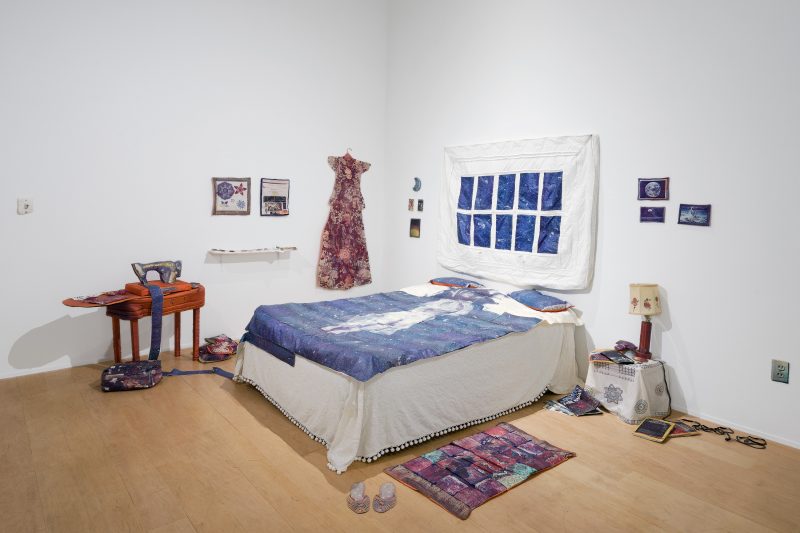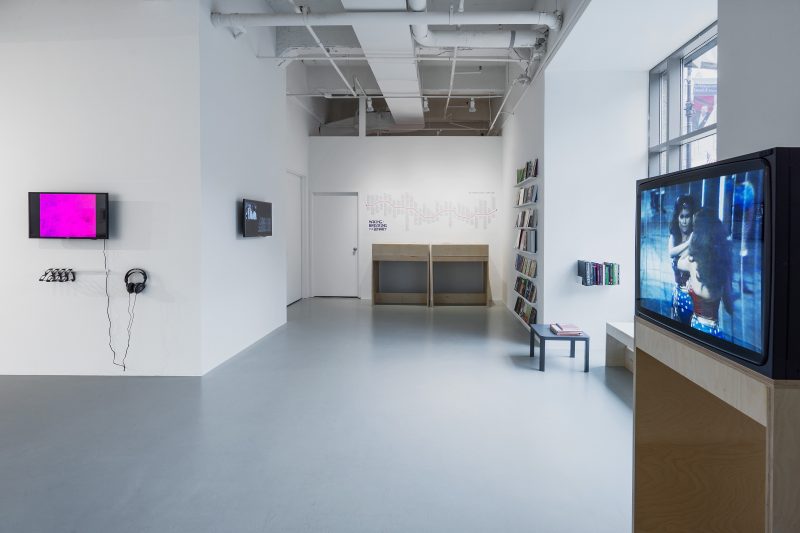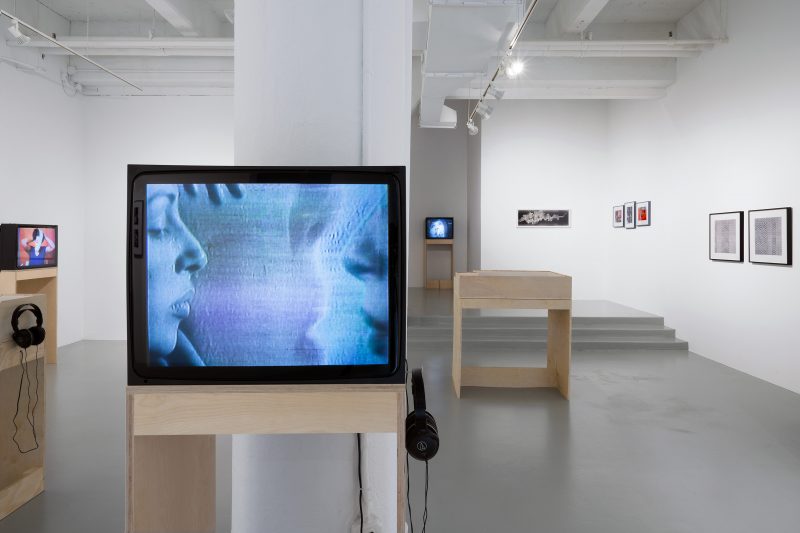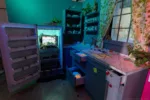Where are women in the history of STEM? Making/Breaking the Binary: Women, Art and Technology proposes a long-overdue look at the lives and careers of women innovators, both as individuals and as members of a complicated and diverse community. In addition to housing numerous and varied examples of technologically generated artwork, the Rosenwald-Wolf Gallery acts as a hub for a reading library and a range of related programs. A blog also documents the biographies of historical and contemporary women in STEM.
The exhibition, curated by Kelsey Halliday Johnson, includes the work of fourteen artists and eight composers whose works pushed the boundaries of technology between the years 1968 and 1985. Fundamentally an art historical survey, the show is incredibly interactive, expansive, and archival, containing audio stations, video art, and a soft-sculpture installation (Catherine Jansen’s Sewing Space — an entire bedroom sewn from space-age themed images, printed on fabric). 2D prints and drawings document project schematics (Lynn Hershman Leeson), or serve programmatic goals (Jennifer Bartlett). Pati Hill’s photocopier prints have a surprisingly delicate and painterly touch that humanizes the mechanically reproduced.

Going through this show, I was reminded of the late Linda Nochlin’s seminal text, Why Have There Been No Great Women Artists? Nochlin answers this question by essentially arguing that ‘talent’ flourishes when a person is not stymied by institutional barriers. The same may be said of women’s place in the history of technology. Some of the artists in the exhibition choose to address these barriers explicitly — others utilize technology to escape them.
From Pati Hill’s adventures with her photocopier to Lillian Schwartz’s 3D video, the show is full of the magic of material discovery. I can’t help but imagine a collective sigh of relief amongst technologically savvy women artists operating in the 1960’s and 1970’s — finally, new materials, without the weight of a patriarchal canon! Here is the raw matter of technology — malleable and unprejudiced, not yet bearing the indentations of an odalisque upon the couch.
Some of the work is explicitly political — Technology/Transformation: Wonder Woman by Dara Birnbaum appropriates tapes of the Wonder Woman television show of the 1970’s, remixing its frames to reveal the insidiously sexist nature of mass media. Other artists in the show reveal a more intimate, personal relationship between artist and medium.

A piece that really strikes me is Shigeko Kubota’s My Father (1975). The artist combines two videos — one of herself mourning her father’s death and another of her father when he was still living. In both segments, a television is seen in the background, featuring a popular Japanese musical program with a woman soulfully crooning into a microphone. Stoic, matter-of-fact statements about her father are interspersed throughout the video, contrasting with Kubota’s emotional display and forming a complicated portrait of grief. (One segment reads, “MY FATHER WOULD RATHER DRINK SAKE THAN JUICE.”) These two black and white videos inhabit worlds split by time and by death — and yet, by editing them together, Kubota makes the viewer inhabit a liminal cinematic space; I watch her watching her father, as they watch a program together, separately, and I am there with them, implicated in the moment, caught as a viewer in the mechanism of the screen.
As a non-white person, I instinctually wish there were a few more artists of color in the show. Yet, this thought leads me back to Nochlin’s essay; she disagrees with a mainstream feminist approach to rectifying patriarchal art history through the insertion and elevation of all the women artists that feminist historians could unearth. Rather, she proposes that we contend with the past as it occurred — the reality that there weren’t many great women artists — and asks us to consider the reasons why. I appreciate Making/Breaking the Binary for its lack of revisionism in regards to race — for avoiding that well-intentioned pitfall of being too aspirational, editing history too liberally, and therefore producing yet another form of tokenism.
The exhibition wittily addresses this issue with work by one black artist who speaks to the problem herself. Howardena Pindell’s bracingly honest video, Free, White and 21, calls out the viewer’s complicity in a racist culture — and that of other artworks in the show. In the video, Pindell plays two roles: one as herself, and another in a blonde wig and heavy makeup — a caricature of a white woman who dismisses Pindell’s experiences and refuses to recognize her own privilege. As herself, Pindell gives earnest testimony to the horrific racism she has experienced; the other character interjects with statements like “you must be paranoid,” ”your symbols aren’t valid unless we validate them,” “you ungrateful little – after all we’ve done for you.”

At first, Pindell’s video seems to be a straightforward lampooning of racism, especially at the hands of white women. However, as the video proceeds, it becomes clear that the narrative is complex. In one scene, Pindell peels off a stretchy mask — in others, she wraps and unwraps her head in white cloth. When she plays the white character, Pindell never really tries to hide herself. To me, this piece speaks to how mainstream racist ideologies can infiltrate artists of color, altering how we behave towards one another, and even changing how we think of ourselves.
Making/Breaking the Binary does a fantastic job, not only expanding an alternate history of women artists and musicians who worked with technology from 1965 to 1985, but also insisting that women have always been crucial to the mainstream history of technology, despite a lack of recognition. The show also illustrates the tricky nature of dealing with history from an intersectional perspective– an incredibly necessary undertaking for this moment. Be prepared to see the show more than once before it comes down on December 8th— there’s a lot to watch, and more to read.









